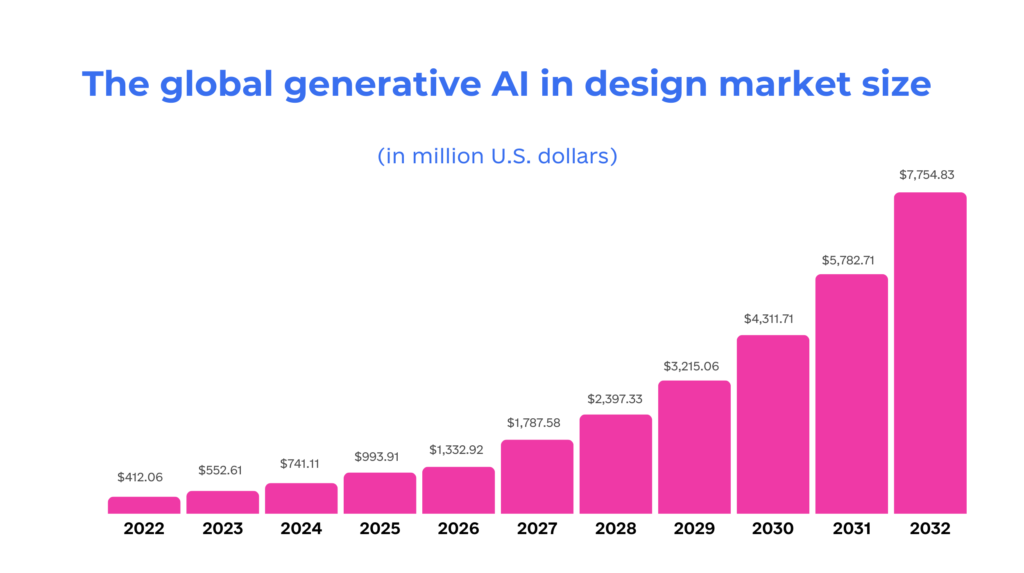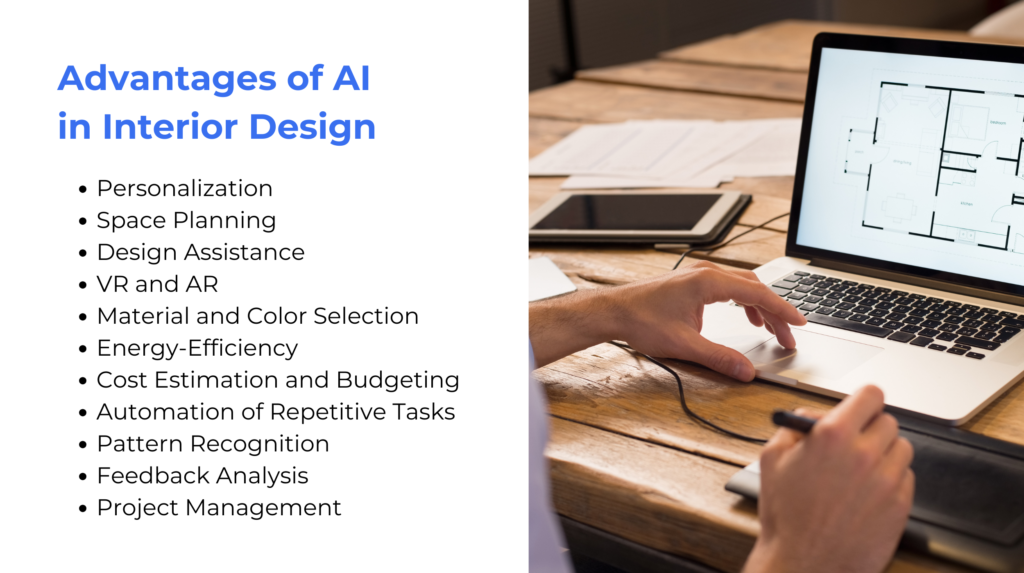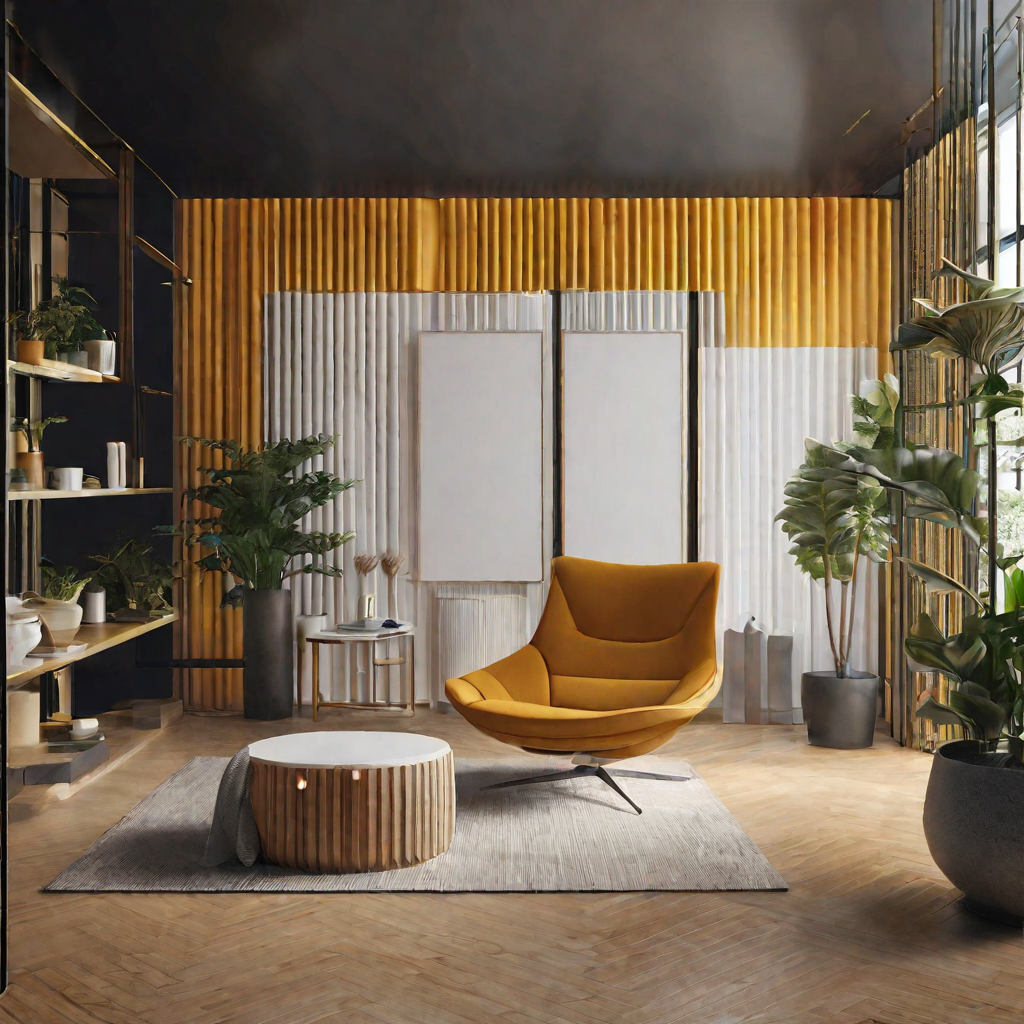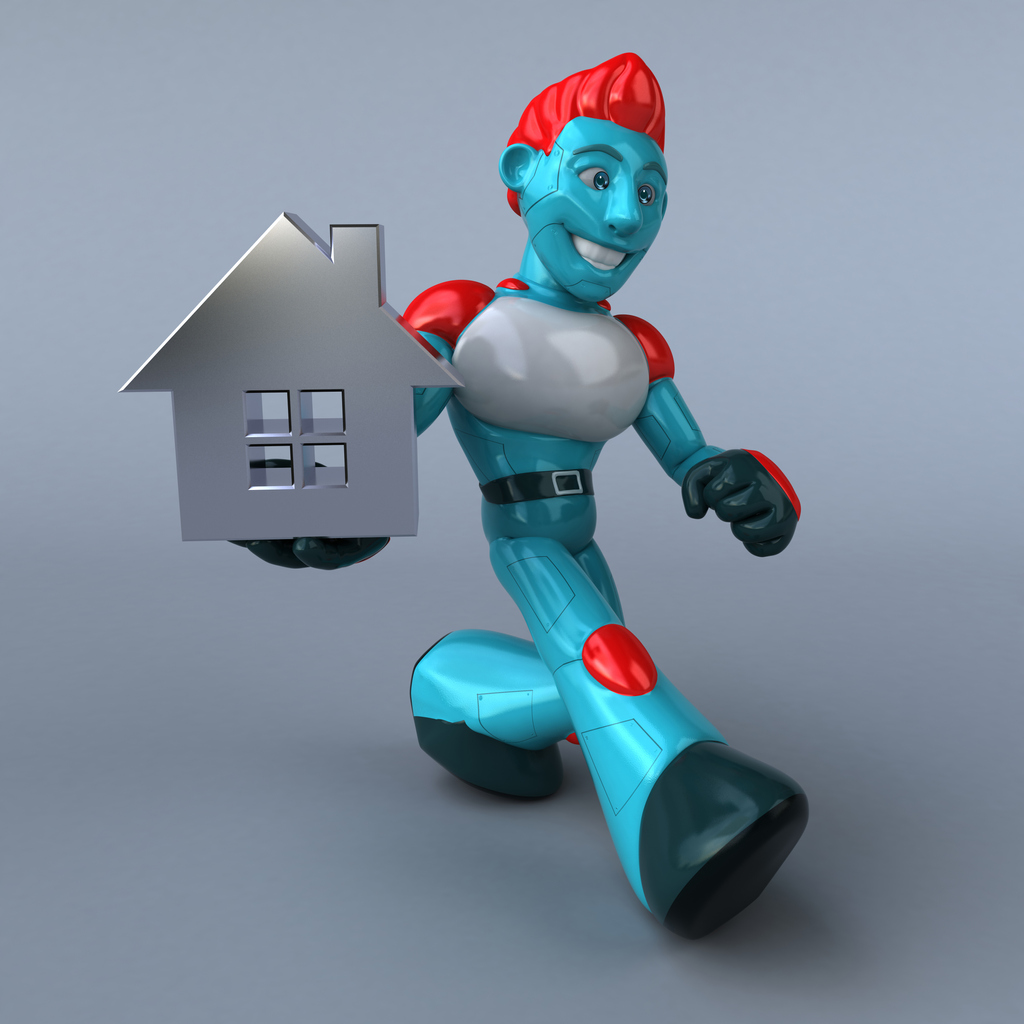Generative AI is a branch of artificial intelligence that uses algorithms to create novel and realistic content, such as images, text, music, and more. Generative AI has many applications in various domains, but one of the most exciting and promising ones is interior design.
Traditionally, interior design requires a lot of human creativity, skill, experience, time, and money. However, with generative AI, interior design can be transformed into a more accessible, efficient, and personalized process.
Estimated Market Reach of Generative AI in Design: 2023-2032
Generative AI in the design market is expected to grow tremendously in the coming years, as it can revolutionize how we design and experience interior spaces.
According to a market research report, the estimated market size of generative AI in design worldwide was $412.06 million in 2022. It is projected to reach approximately $7,754.83 million by 2032 – a robust compound annual growth rate (CAGR) of 34.11% throughout the forecast period from 2023 to 2032.

The growth of generative AI in the design market is driven by several factors, such as the increasing demand for personalized and customized design solutions, the rising adoption of cloud-based services and platforms, the growing availability of data and computational power, the advancements in machine learning techniques, and the emergence of new applications and use cases in various domains.
What Is Generative AI?
Generative AI is a powerful and revolutionary technology that can change how we design and experience interior spaces. Generative AI can enable us to create more beautiful, comfortable, and sustainable environments that suit our personal and professional needs.
Generative AI uses artificial intelligence algorithms to create novel and realistic content for various design applications, such as images, text, music, and more. The AI tool can help designers and customers explore, visualize, and optimize different design options based on their preferences, needs, and budget.
Interior designers can use AI tools to enhance the interior of a space to achieve a more aesthetically pleasing environment for the residents. Generative AI in design can generate realistic and high-quality images of the interior spaces, allowing the users to see how they would look in real life.
What Is the Difference Between AI and Generative AI?
Artificial intelligence (AI) and generative AI are two related but distinct fields of computer science that aim to emulate human-like intelligence and creativity.
AI is the general term encompassing any system that can perform tasks that normally require human intelligence, such as understanding, reasoning, learning, and interacting. AI can be applied to various domains, such as natural language processing, computer vision, speech recognition, robotics, etc.
Generative AI is a specific branch of AI that focuses on creating new and original content, such as text, images, audio, video, and more, based on patterns and structures learned from existing data. Generative AI can produce realistic, diverse, and novel content and can be used for various applications, such as design, art, entertainment, education, and more.
| AI | Generative AI |
| A broad term that encompasses performing tasks that require human-like intelligence. | The specific branch of AI that focuses on creating new and original content. |
| Creating content through understanding, reasoning, learning, and interacting with data. | Creating new and original content based on patterns and structures learned from existing data. |
| Can analyze and interpret data | Can synthesize and generate data |
What Is Generative AI in Interior Design, and How Does It Work?
Generative AI tools use neural networks to learn patterns and structures from existing data or given parameters and then synthesize and generate new, realistic, diverse, and novel content.
Generative AI in interior design uses different data types, such as text, images, sketches, or voice, as inputs or outputs. For example, a user can type a text description of their desired room, and the generative AI system can produce an image that matches the description.
Alternatively, users can upload an image of their existing room, and the generative AI system can suggest different design changes or improvements.

Generative AI in interior design can use different AI/ML algorithms, such as generative adversarial networks (GANs), variational autoencoders (VAEs), or transformers, to create content. These algorithms can be trained on large datasets of interior design images, text, or other data to learn the features and styles of different design elements, such as colors, shapes, textures, lighting, and more. These algorithms can also be customized or fine-tuned to suit different design domains, such as residential, commercial, or hospitality.
Benefits of Use of Artificial Intelligence in Interior Design
Generative AI in interior design is a promising and exciting field that can transform how we design and experience interior spaces. Generative AI in interior design can enable us to create more beautiful, comfortable, and sustainable environments that suit our personal and professional needs.
The use of generative AI in interior design can foster the evolution and innovation of the real estate industry by enhancing the property market’s efficiency, effectiveness, and satisfaction. Here are some key advantages of using generative AI in interior design.

Personalization
- Generative AI tools can analyze user preferences and behavior to create highly personalized design recommendations.
- Tailored designs cater to individual tastes, ensuring a unique and satisfying client experience.
Space Planning
- Generative AI algorithms can optimize space utilization based on the available dimensions and functional requirements.
- Efficient space planning contributes to better functionality and aesthetic appeal in interior design.
Design Assistance
- Generative AI tools assist designers by generating design suggestions, color palettes, and furniture arrangements.
- Automated design assistance speeds up the creative process, providing inspiration and ideas for designers.
Read also: Synthetic Image and Data Generation
Virtual Reality (VR) and Augmented Reality (AR)
- AI-powered VR and AR technologies allow clients to experience virtual walkthroughs of their designs before implementation.
- Generative AI tools can help visualize and refine the design, reducing the chances of dissatisfaction with the result.
Material and Color Selection
- Generative AI can analyze trends, user preferences, and historical data to recommend suitable materials and color schemes.
- Improved decision-making in material and color selection contributes to cohesive and aesthetically pleasing designs.
Energy-Efficiency
- Generative AI can optimize lighting, heating, and cooling systems for energy efficiency.
- Smart, AI-driven solutions help reduce interior spaces’ environmental impact and energy costs.
Cost Estimation and Budgeting
- Generative AI tools can analyze historical cost data and project requirements for accurate cost estimation.
- This helps in budgeting and ensures that design plans align with financial constraints.
Automation of Repetitive Tasks
- Generative AI can automate mundane and repetitive tasks, allowing designers to focus on more creative aspects of their work.
- Time-saving automation enhances overall efficiency and productivity.
Pattern Recognition
- Generative AI can identify patterns in design preferences, helping designers stay informed about current trends and user preferences.
- The AI tools enable the creation of designs that are more likely to resonate with the target audience.
Feedback Analysis
- Generative AI can analyze feedback from clients and users to improve future design iterations.
- Continuous feedback analysis helps refine the design process and adapt to changing preferences.
Project Management
- AI-powered project management tools help in scheduling, task allocation, and progress tracking.
- Improved project management contributes to the timely completion of interior design projects.
To summarize, Generative AI brings many advantages to interior design by enhancing personalization, efficiency, visualization, and decision-making throughout the design process. As technology continues to advance, the integration of AI is likely to play an increasingly important role in shaping the future of interior design.
Use Cases of Generative AI in Interior Designing
Interior design is an artful blend of creativity, functionality, and aesthetic appeal. It’s a field that constantly evolves, seeking innovative ways to transform spaces into visually captivating and harmonious environments. With the advent of technology, specifically Generative AI, the realm of interior design has witnessed a significant transformation, unlocking new possibilities and streamlining various processes. Here are some compelling use cases of Generative AI in interior designing:
Space Planning and Layout Generation
Generative AI algorithms can analyze space constraints and user requirements to generate optimized floor plans and layouts. By considering factors like room dimensions, traffic flow, and functional needs, these tools assist designers in creating efficient and well-designed spaces.
Customized Furniture and Fixtures
AI-driven design tools aid in crafting bespoke furniture pieces and fixtures tailored to specific spaces. Whether it’s generating unique chair designs or custom lighting solutions, these systems can generate numerous iterations based on user preferences, material choices, and spatial constraints.
Color Palette and Material Selection
Choosing the right color schemes and materials is crucial in interior design. Generative AI tools can assist designers by suggesting color palettes, textures, and material combinations based on desired themes, moods, or even cultural inspirations, enabling more informed and visually appealing choices.
Enhanced Visualization and 3D Rendering
Generative AI algorithms enable realistic 3D renderings and simulations of interior spaces. These tools provide a more immersive experience for clients, allowing them to visualize designs accurately before execution, thereby reducing potential misunderstandings and alterations.
Design Pattern Generation
From intricate wallpapers to unique floor patterns, AI algorithms aid in generating diverse and innovative design patterns. These patterns can be customized according to specific preferences and spatial requirements, adding a touch of uniqueness to interior spaces.
Check Our Generative AI-Powered Interior Design Platform Solution
Personalized Design Recommendations
AI-powered recommendation systems analyze user preferences, style choices, and trends to offer personalized design suggestions. These systems assist both designers and clients in making informed decisions aligned with their tastes and preferences.
Sustainable Design Solutions
Generative AI tools help in optimizing designs for sustainability by suggesting eco-friendly materials, energy-efficient layouts, and innovative solutions that reduce environmental impact, promoting a more sustainable approach in interior design.
Adaptive Design for Accessibility
AI-powered design tools aid in creating spaces that cater to diverse needs, considering accessibility and inclusivity factors. These tools assist in designing spaces that are more accommodating and user-friendly for individuals with disabilities or special requirements.
The Future of Generative AI in Interior Design
Generative AI in design is a promising and exciting field that has a lot of potential and opportunities for the future. The AI tool can foster the evolution and innovation of the real estate industry by enhancing the property market’s efficiency, effectiveness, and satisfaction.
Generative AI will also have a profound effect on interior design. The AI tool will automate and augment many knowledge work activities, such as writing, designing, coding, and more, and create new opportunities and challenges for interior designers.
Generative AI is a powerful and revolutionary technology with many potential applications and opportunities for the future. But it also poses some risks and challenges. AI algorithms are trained on data, and this data can be biased. It is important to be aware of this bias and to take steps to mitigate it.
Additionally, ethical considerations need to be addressed, such as the potential for AI to be used to create discriminatory or harmful designs.
Strategies for Employing Generative AI in Interior Design
Generative AI brings many advantages to interior design by enhancing personalization, efficiency, visualization, and decision-making throughout the design process.
Generative AI can enable us to create more beautiful, comfortable, and sustainable environments that suit our personal and professional needs. Using AI tools can also foster the real estate industry’s evolution and innovation by enhancing the property market’s efficiency, effectiveness, and satisfaction.
Before implementing generative AI, you should clearly understand what problems you want to solve, what value you want to create, and what use cases you want to address with generative AI. It will help you align your generative AI strategy with your business goals and priorities and measure your outcomes and impact.
Generative AI in interior design can be a creative and effective way to streamline the design process and generate unique, personalized designs.
Here are some strategies for implementing Generative AI in interior design:
Data Collection and Analysis:
- Gather a diverse dataset of interior design examples, including different styles, color schemes, furniture arrangements, and layouts.
- Use data analysis techniques to identify patterns, preferences, and popular design elements within the dataset.
Define Design Constraints:
- Establish clear design constraints and requirements with clients. This includes preferences, budget limitations, room dimensions, and any specific design elements they want to include.
Generative Models:
- Choose appropriate generative models such as Generative Adversarial Networks (GANs) or Variational Autoencoders (VAEs) based on the project requirements.
- Train the model on the collected dataset to learn the patterns and characteristics of interior designs.
User Interaction:
- Implement a user-friendly interface that allows clients to input their preferences, constraints, and any specific ideas they have in mind.
- Incorporate feedback loops to refine generated designs based on client input.
Style Transfer and Fusion:
- Experiment with style transfer techniques to allow users to explore different design styles for a given space.
- Explore methods for fusing multiple design elements from different styles to create a unique and personalized design.
Customization and Personalization:
- Enable customization options, allowing users to modify specific aspects of the generated design, such as furniture placement, color schemes, or room layouts.
- Implement algorithms that consider user preferences to tailor the generated designs to individual tastes.
Real-time Rendering and Visualization:
- Integrate real-time rendering and visualization tools to provide clients with immersive experiences of the generated designs.
- Utilize Virtual Reality (VR) or Augmented Reality (AR) technologies to allow clients to virtually experience their designed spaces.
Performance Metrics and Evaluation:
- Define metrics to evaluate the quality of generated designs, such as coherence, functionality, and adherence to design constraints.
- Continuously refine and improve the generative model based on user feedback and evaluation metrics.
Collaboration with Design Professionals:
- Involve interior designers and architects in the process to provide expertise, guide the model training, and ensure that generated designs meet industry standards and regulations.
Ethical Considerations:
- Address ethical considerations, such as data privacy, transparency in design decisions, and avoiding biases in the generated designs.
Iterative Development:
- Adopt an iterative development process, allowing for continuous improvement and adaptation of the generative model based on user feedback and changing design trends.
By combining these approaches, you can create a robust and effective Generative AI system for interior design that enhances the design process, fosters creativity, and delivers personalized solutions for clients.
Conclusion
Interior design involves many aspects, such as color, lighting, furniture, materials, layout, and style. Generative AI can help interior designers and customers explore, visualize, and optimize different design options based on their preferences, needs, and budget.
The use of Generative AI is predicted to have a significant impact on the real estate industry, which is closely related to interior design. Using the AI tool can help improve properties’ attractiveness, functionality, and value.
With generative AI, real estate agents and customers can benefit from a more innovative and convenient way of showcasing and exploring properties. Generative AI can create realistic and customized images of the interior spaces based on the user’s input and feedback.
Navigating the complexities of developing Generative AI in interior design solutions demands a partner with a solid track record. Achievion stands as a beacon of experience, providing a wealth of expertise that empowers interior designers and clients alike. As the Real estate industry undergoes a transformative shift, Generative AI is poised to play a pivotal role. Its application promises to significantly enhance the attractiveness, functionality, and value of properties. Achievion, with its expertise, is well-positioned to lead clients through this transformative journey.
Experience the future of interior design and real estate by partnering with Achievion. Contact us using the form at the bottom to explore the boundless possibilities that Generative AI offers.








![How to Use ChatGPT for Real Estate [2024 Guide]](https://achievion.com/wp-content/uploads/2024/03/How-to-Use-ChatGPT-for-Real-Estate-2-1024x573.png)
